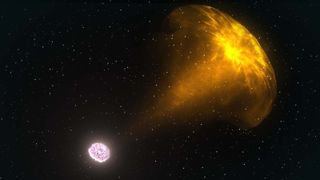Something keeps exploding in space and astronomers have no idea what it is
Bizarre source of fast radio burst keeps exploding over and over

After watching a bizarre space object repeatedly explode over 1,600 times in fairly short order, astronomers are still at a loss as to what it actually is.
The object is the source of a fast radio burst (FRB), a strange space phenomenon that was only discovered in 2007 and of which very little is known.
There are some patterns to them though. Most seem to release their energy in one go while a few have been observed repeatedly releasing bursts of energy.
One of these FRBs is an object called FRB 121102 located in a dwarf galaxy about 3 billion light-years from us. Using China's Five-hundred-meter Aperture Spherical Radio Telescope (FAST), the astronomers studied FRB 121102 for some time to try to simply gather data on it.
"Initially, it was just stamp collecting," said Bing Zhang, an astrophysicist at the University of Nevada, Las Vegas, in a statement to our colleagues over at Live Science.
After watching FRB 121102 for about 60 hours, the researchers watched it explode 1,652 times, with its fastest pace being roughly one explosion every 30 seconds.
FRBs are difficult to study, largely because they have nearly always been found outside our galaxy and usually at a considerable distance even in universal terms. In 2020, though, a FRB was found in our own galaxy and scientists were able to identify it as a magnetar, which is a particular kind of stellar corpse known as a neutron star.
Get daily insight, inspiration and deals in your inbox
Get the hottest deals available in your inbox plus news, reviews, opinion, analysis and more from the TechRadar team.
It's too soon to tell if all FRBs are magnetars or if magnetars are just one possible source of FRBs. We also don't know how magnetars give rise to an FRB, so it's hard to even know what to look for in FRB 121102.
Zhang was able to rule out gases and dust surrounding the source as a cause, since the quick succession of explosions didn't give enough time for those kinds of material to gather in large enough quantity to fuel the next explosion.
Analysis: everyone, especially scientists, love a good mystery
Most space objects are fascinating in their own right, even as we learn more and more about them... as there is always more to learn about them.
But FRBs are especially exciting because they are a rare mystery in science in that we know almost nothing about them. They're also a relatively new discovery, so there's plenty of new research opportunities in studying them.
We don't know what causes them beyond knowing that a magnetar might be behind the phenomenon, but it's hard to understand what could cause a magnetar to explode more than 1,600 over the course of a typical weekend.
The mystery is an exciting one, and with new instruments like FAST coming online that are even better at finding new signals in radio and other previously inaccessible wavelengths of light, hopefully there will be even more mysteries out there for us to discover... and potentially solve.

John (He/Him) is the Components Editor here at TechRadar and he is also a programmer, gamer, activist, and Brooklyn College alum currently living in Brooklyn, NY.
Named by the CTA as a CES 2020 Media Trailblazer for his science and technology reporting, John specializes in all areas of computer science, including industry news, hardware reviews, PC gaming, as well as general science writing and the social impact of the tech industry.
You can find him online on Threads @johnloeffler.
Currently playing: Baldur's Gate 3 (just like everyone else).
